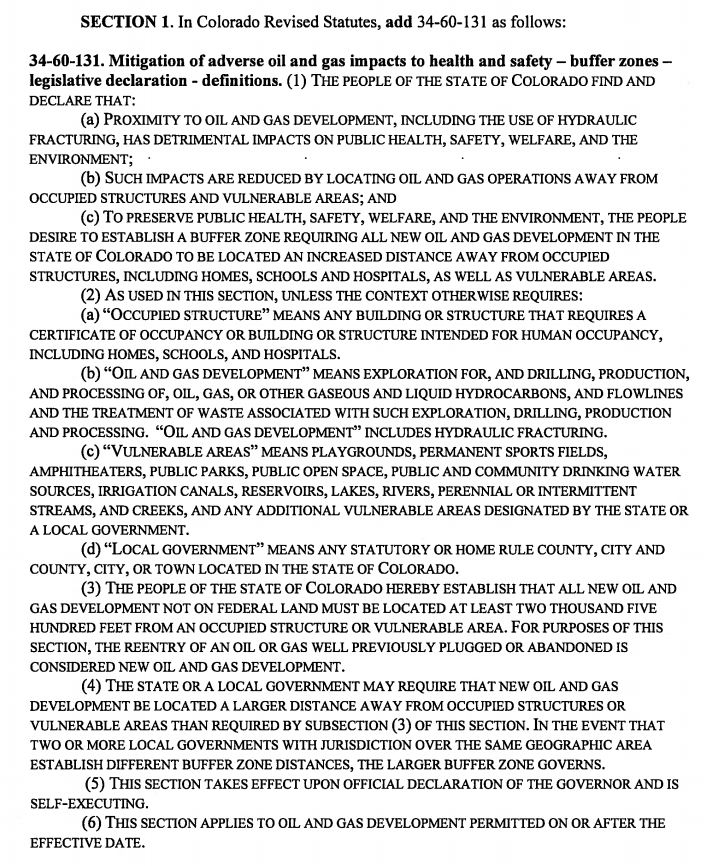98,492 verified voter signatures are required to make the ballot – Macquarie Research believes proponents have turned in ~170,000 signatures
Colorado ballot initiative 97, the proposed change to state statute–changing the law to impose mandatory 2,500-foot drilling setbacks around protected areas like rivers and water sources and all occupied structures, and give local governments their own power to impose bigger setbacks–may have taken a giant leap closer to becoming reality.
Secretary of State Wayne Williams’ office reported on Twitter after 12:30 p.m. that initiative 97 signatures had been turned in. The Secretary of State’s office also confirmed with Oil & Gas 360© via email that the petitions are in, but the office would not report any numbers or any other details as of yet.
Macquarie Research reported in an equity research note this afternoon that proponents of initiative 97 had turned in enough signatures, in the firm’s estimation, for the measure to make it to the November ballot. “We believe the Initiative is likely to make the November ballot,” Macquarie said in its note. “This is a large negative for Colorado names and one that creates a meaningful overhang until November.”
“The supporters are indicating they have turned in over 170,000+,” Macquarie said in the note. “The quick take away is we believe that Initiative 97 WILL likely pass the verification process based on the number of signatures submitted.”
Signature verification can take up to 30 days, according to the Secretary of State. The research group believes the verification process for 97 will likely take about three weeks. In 2016, setback proponents turned in signatures for a constitutional amendment requiring a 2,500-foot setback for oil and gas drilling, but the groups behind the initiative failed to garner enough verified signatures and the initiative failed to make the ballot.
Macquarie said it believes “that 130,000-150,000+ signatures are required to meet the threshold of 98,492 verified signatures. “We rely upon the Secretary of State’s initial estimate for our initial conclusion. Admittedly, there is some uncertainty in the number but we believe the market has not believed in this outcome and stocks will react negatively until proven otherwise.”
The statistical analysis of the signatures will look at a 5 percent random sample and test to confirm if needed number has been reached. If the extrapolated analysis demonstrates they would be below 90% of the 98,492 verified signatures, the initiative is denied. If it is above 110% of the 98,492 signatures, it is placed on the ballot (subject to appeals) and between 90% and 110% a full count is undertaken, Macquarie reported in the note.
In a separate press release, the Secretary of State said, “Today’s deadline was to turn in 98,492 valid voter signatures, which is 5 percent of the total votes cast for all candidates for Secretary of State in the 2014 general election. A random sample of signatures is then conducted.”
Since this year’s initiative 97 was put forth as a voter initiative to change Colorado statues, rather than to amend the constitution, only a simple majority of votes is required. The 2016 version of the setback initiative was put forward as a change, or amendment, to the Colorado constitution. That process became tougher after voters two years ago approved Amendment 71, which makes it more difficult to amend the constitution. In addition to requiring that signatures come from 2 percent of voters in each Senate district, the measure also required constitutional amendments to pass with a 55-percent majority rather than a simple majority.
Read prior coverage of 97 here.
Initiative 97 would effectively stop most new drilling and development in the more densely populated areas of Colorado, including the Wattenberg field, by removing a huge percentage of surface area from drilling and development. The initiative would designate 2500-foot buffer zones around “occupied structures” and “vulnerable areas.”
The Colorado Oil and Gas Conservation Commission (COGCC), Colorado’s oil and gas regulator, has released acreage-reduction calculations based on a successful initiative 97, saying that of the 7 million acres of non-federal land in Colorado’s top oil and gas producing counties, proposed initiative #97 would exclude 6.5 million acres from drilling and development. That’s a 93% reduction in non-federal land available to drill. The number could go higher as the initiative provides for local municipalities to impose bigger setbacks to remove areas from availability for drilling as they see fit.


